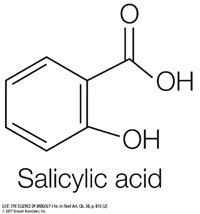Systemic acquired resistance is a form of long-term immunity
Thus far we have described the events that occur in plant cells at or near the site of invasion by a pathogen. In both general and specific immunity, the infected cells also send hormonal signals to the rest of the plant, stimulating a systemic response. Systemic acquired resistance is a general increase in the resistance of the entire plant to a wide range of pathogens. It is not limited to the pathogen that originally triggered it, or to the site of the original infection, and its effect may last as long as an entire growing season.
This defensive response is initiated by the plant hormone salicylic acid.

Salicylic acid production is triggered by receptor binding in both general and specific immunity; salicylic acid then functions as a signal that mediates various defense responses. For example, salicylic acid triggers the production of reactive oxygen species and the induction of genes that encode PR proteins. There are many classes of PR proteins, which function in various ways to protect plants against insect attack and against invasion by fungi, bacteria, viruses, and nematodes.
These responses occur at the site of infection and, to a lesser extent, throughout the plant. A derivative of salicylic acid can form a gas that can travel through the air, carrying the defense signal not only to other parts of the same plant but to other nearby plants. Plant-
Another type of systemic acquired resistance is a more specific defense against viruses with RNA genomes. The plant uses its own enzymes to convert some of the single-